MODIS Fractional Snow Cover Mapping Using Machine Learning Technology in a Mountainous Area
Abstract
1. Introduction
2. Study Area
3. Data and Methodology
3.1. Data
3.1.1. UAVs
3.1.2. Landsat
3.1.3. MODIS
3.1.4. Auxiliary Data
3.2. Landsat Snow Cover Mapping Algorithm
3.3. Machine Learning
3.4. Validation
4. Result
4.1. Parameter Sensitivity Test
4.2. FSC Mapping
4.3. Accuracy Verification
5. Discussion
6. Conclusions
- (1)
- Compared with MOD10A1, the machine learning FSC algorithms employed in this study can significantly improve the FSC mapping accuracy. The FSC distributions generated by the three machine learning models are close to (or slightly overestimate) the real FSC obtained by Landsat. However, MOD10A1 severely underestimates the FSC in the TP.
- (2)
- The land cover type is the main factor affecting the FSC inversion accuracies of the machine learning algorithms and MOD10A1. Machine learning algorithms can significantly reduce the effects of different land cover types on the extraction of FSC using MODIS. In particular, the RF algorithm significantly improves the FSC extraction accuracy in forestland and shrubland. The RMSEs of the RF model in forestland and shrubland are only 0.13 and 0.18, respectively, whereas the corresponding MOD10A1 RMSEs are 0.21 and 0.23, respectively.
- (3)
- Various FSC gradients also affect the FSC inversion accuracy. The accuracy of MOD10A1 decreases with an increasing FSC gradient. The accuracies of the three machine learning models also change with the FSC gradient, although they still achieve acceptable accuracy compared to MOD10A1. Ultimately, the RF model performs the best with the most stable accuracy among the three machine learning models.
- (4)
- Finally, the RF algorithm shows high accuracies, which are normally unaffected by changes in the land cover types and FSC gradients in the TP. Therefore, this study proposed that the RF algorithm is the most effective method for resolving the problems associated with fragmented snow cover in the complex terrain of the TP. Hence, using the RF model can improve the FSC inversion accuracy from MODIS data compared with MOD10A1.
Author Contributions
Funding
Acknowledgments
Conflicts of Interest
References
- Barnett, T.P.; Adam, J.C.; Lettenmaier, D.P. Potential impacts of a warming climate on water availability in snow-dominated regions. Nature 2005, 438, 303–309. [Google Scholar] [CrossRef] [PubMed]
- Domine, F.; Barrere, M.; Sarrazin, D.; Samuel, M. Automatic monitoring of the effective thermal conductivity of snow in a low-Arctic shrub tundra. Cryosphere 2015, 9, 1633–1665. [Google Scholar] [CrossRef]
- Bair, E.H.; Davis, R.E.; Dozier, J. Hourly mass and snow energy balance measurements from Mammoth Mountain, CAUSA, 2011–2017. Earth Syst. Sci. Data 2018, 10, 549–563. [Google Scholar] [CrossRef]
- Zhao, P.; Zhou, Z.J.; Liu, J.P. Variability of Tibetan spring snow and its associations with the hemispheric extratropical circulation and east Asian summer monsoon rainfall: an observational investigation. J. Clim. 2007, 20, 3942–3955. [Google Scholar] [CrossRef]
- Qian, Y.F.; Zheng, Y.; Zhang, Y. Responses of China’s summer monsoon climate to snow anomaly over the Tibetan Plateau. Int. J. Climatol. 2003, 23, 593–613. [Google Scholar] [CrossRef]
- Wu, Z.W.; Zhang, P.; Chen, H. Can the Tibetan Plateau snow cover influence the interannual variations of Eurasian heat wave frequency? Clim. Dyn. 2016, 46, 3405–3417. [Google Scholar] [CrossRef]
- Wang, S.Y.; Wang, X.Y.; Chen, G.S. Complex responses of spring alpine vegetation phenology to snow cover dynamics over the Tibetan Plateau, China. Sci. Total Environ. 2017, 593–594, 449–461. [Google Scholar] [CrossRef] [PubMed]
- Wang, X.Y.; Wu, C.Y.; Peng, D.L. Snow cover phenology affects alpine vegetation growth dynamics on the Tibetan Plateau: Satellite observed evidence, impacts of different biomes, and climate drivers. Agric. For. Meteorol. 2018, 256–257, 61–74. [Google Scholar] [CrossRef]
- Wang, W.; Liang, T.G.; Huang, X.D.; Feng, Q.S.; Xie, H.J.; Liu, X.Y.; Chen, M.; Wang, X.H. Early warning of snow-caused disasters in pastoral areas on the Tibetan Plateau. Nat. Hazards Earth Syst. Sci. 2013, 13, 1411–1425. [Google Scholar] [CrossRef]
- Huang, X.D.; Deng, J.; Wang, W.; Feng, Q.S.; Liang, T.G. Impact of climate and elevation on snow cover using integrated remote sensing snow products in Tibetan Plateau. Remote Sens. Environ. 2017, 190, 274–288. [Google Scholar] [CrossRef]
- Hao, X.H.; Luo, S.Q.; Che, T.; Wang, J.; Li, H.Y.; Dai, L.Y.; Huang, X.D.; Feng, Q.S. Accuracy accessment of four cloud-free snow cover porducts over the Qinghai-Tibetan Plateau. Int. J. Digit. Earth 2018, 12, 375–393. [Google Scholar] [CrossRef]
- Zhang, Y.; Huang, X.D.; Wang, W.; Liang, T.G. Validation and Algorithm Redevelopment of MODIS Daily Fractional Snow Cover Products. Arid Zone Res. 2013, 30, 808–814. (In Chinese) [Google Scholar]
- Hall, D.K.; Riggs, G.A.; Salomonson, V.V. Development of methods for mapping global snow cover using moderate resolution imaging spectroradiometer data. Remote Sens. Environ. 1995, 54, 127–140. [Google Scholar] [CrossRef]
- Hao, X.H.; Wang, J.; Wang, J.; Huang, X.D.; Li, H.Y.; Liu, Y. Observations of Snow Mixed Pixel Spectral Characteristics Using a Ground-Based Spectral Radiometer and Comparing with Unmixing Algorithms. Spectrosc. Spectr. Anal. 2012, 32, 2753. (In Chinese) [Google Scholar]
- Brown, R.D.; Robinson, D.A. Northern Hemisphere spring snow cover variability and change over 1922–2010 including an assessment of uncertainty. Cryosphere 2011, 219–229. [Google Scholar] [CrossRef]
- Hori, M.; Sugiura, K.; Kobayashi, K.; Aoki, T.; Tanikawa, T.; Kuchiki, K.; Niwano, M.; Enomoto, H. A 38-year (1978–2015) Northern Hemisphere daily snow cover extent product derived using consistent objective criteria from satellite-borne optical sensors. Remote Sens. Environ. 2017, 191, 402–418. [Google Scholar] [CrossRef]
- Metsämäki, S.; Pulliainen, J.; Salminen, M.; Luojus, K.; Wiesmann, A.; Solgerg, R.; Böttcher, K.; Hiltunen, M.; Ripper, E. Introduction to GlobSnow Snow Extent products with considerations for accuracy assessment. Remote Sens. Environ. 2015, 156, 96–108. [Google Scholar] [CrossRef]
- Schattan, P.; Schwaizer, G.; Schöber, J.; Achleitner, S. The complementary value of cosmic-ray neutron sensing and snow covered products for snow hydrological modelling. Remote Sens. Environ. 2020, 239, 111603. [Google Scholar] [CrossRef]
- Nagler, T.; Rott, H.; Ripper, E.; Bippus, G.; Hetzenecker, M. Advancements for snowmelt monitoring by means of Sentinel-1 SAR. Remote Sens. 2016, 8, 348. [Google Scholar] [CrossRef]
- Simic, A.; Fernandes, R.; Brown, R.; Romanov, P.; Park, W. Validation of vegetation, MODIS, and GOES + SSM/ I snow cover products over Canada based on surface snow depth observations. Hydrol. Process. 2004, 18, 1089–1104. [Google Scholar] [CrossRef]
- Liang, T.G.; Huang, X.D.; Wu, C.X.; Liu, X.Y.; Li, W.D.; Guo, Z.G.; Ren, J.Z. An application of MODIS data to snow cover monitoring in a pastoral area: A case study in Northern Xinjiang, China. Remote Sens. Environ. 2008, 112, 1514–1526. [Google Scholar] [CrossRef]
- Wang, W.; Huang, X.D.; Deng, J.; Xie, H.J.; Liang, T.G. Spatio-temporal change of snow cover and its response to climate over the Tibetan Plateau based on an improved daily cloud-free snow cover product. Remote Sens. 2015, 7, 169–194. [Google Scholar] [CrossRef]
- Yu, J.Y.; Zhang, G.Q.; Yao, T.D.; Xie, H.J.; Zhang, H.B.; Ke, C.Q.; Yao, R.Z. Developing daily cloud-free snow composite products from MODIS Terra-Aqua and IMS for the Tibetan Plateau. IEEE Trans. Geosci. Remote Sens. 2016, 54, 2171–2180. [Google Scholar] [CrossRef]
- Zhang, Y.; Huang, X.D.; Hao, X.H.; Wang, J.; Wang, W.; Liang, T.G. Fractional snow-cover mapping using an improved endmember extraction algorithm. J. Appl. Remote Sens. 2014, 8, 084691. [Google Scholar] [CrossRef]
- Liang, H.; Huang, X.D.; Sun, Y.H.; Wang, Y.L.; Liang, T.G. Fractional snow-cover mapping based on MODIS and UAV data over the Tibetan Plateau. Remote Sens. 2017, 9, 1332. [Google Scholar] [CrossRef]
- Hou, J.L.; Huang, C.L. An application of ANN for mountainous snow cover fraction mapping with MODIS and ancillary topographic data. Geosci. Remote Sens. Symp. 2014, 14058963. [Google Scholar]
- Czyzowska, E.H.; Leeuwen, W.J.; Hirschboeck, K.K. Fractional snow cover estimation in complex alpine-forested environments using an artificial neural network. Remote Sens. Environ. 2015, 156, 403–417. [Google Scholar] [CrossRef]
- Ge, J.; Meng, B.P.; Yang, S.X. Dynamic monitoring of alpine grassland coverage based on UAV technology and MODIS remote sensing data—A case study in the headwaters of the Yellow River. Acta Pratacult. Sin. 2017, 26, 1–12. (In Chinese) [Google Scholar]
- Wang, X.Y.; Jian, W.; Che, T.; Huang, X.D.; Hao, X.H.; Li, H.Y. Snow Cover Mapping for Complex Mountainous Forested Environments Based on a Multi-Index Technique. IEEE J-STARS 2018, 11, 1433–1441. [Google Scholar] [CrossRef]
- Yang, D.; Zhou, C.; Zhou, H.O.; Chen, C. Characteristics of Variation in Runoff across the Nyangqu River Basin in the Qinghai-Tibet Plateau. J. Resour. Ecol. 2012, 3, 80–86. [Google Scholar]
- Chang, Q.F.; Lai, Z.P.; An, F.Y. Chronology for terraces of the Nalinggele River in the north Qinghai-Tibet Plateau and implications for salt lake resource formation in the Qaidam Basin. Quat. Int. 2016, 430, 12–20. [Google Scholar] [CrossRef]
- Damien, S.M.; Friedl, M.A. User Guide to Collection 6 MODIS Land Cover (MCD12Q1 and MCD12C1) Product; USGS: Reston, VA, USA, 2018. [CrossRef]
- Hall, D.K.; Riggs, G.A. MODIS/Terra Snow Cover Daily L3 Global 500 m SIN Grid, 6th ed.; NASA Natinal Snow and Ice Data Center: Boulder, CO, USA, 2016. [Google Scholar] [CrossRef]
- He, Q. Neural Network and its Application in IR; Graduate School of Library and Information Science, University of Illinois at Urbana-Champaign Spring: Champaign, IL, USA, 1999. [Google Scholar]
- Hao, S.R.; Jiang, L.M.; Shi, J.C.; Wang, G.X.; Liu, X.J. Assessment of MODIS-Based Fractioal Snow Cover Products Over the Tibetan Plateau. IEEE J. Sel. Top. Appl. Earth Observ. Remote Sens. 2018, 99, 1–16. [Google Scholar]
- Tiryaki, S.; Aydın, A. An artificial neural network model for predicting compression strength of heat treated woods and comparison with a multiple linear regression model. Constr. Build. Mater. 2014, 62, 102–108. [Google Scholar] [CrossRef]
- Breiman, L. Random Forests. Mach. Learn. 2001, 45, 5–32. [Google Scholar] [CrossRef]
- Verrelst, J.; Camps, V.G.; Muñoz-Marí, J. Optical remote sensing and the retrieval of terrestrial vegetation bio-geophysical properties-A review. ISPRS-J. Photogramm. Remote Sens. 2015, 108, 273–290. [Google Scholar] [CrossRef]
- Johnson, B. Scale Issues Related to the Accuracy Assessment of Land Use/Land Cover Maps Produced Using Multi-Resolution Data: Comments on “The Improvement of Land Cover Classification by Thermal Remote Sensing”. Remote Sens. 2015, 7, 8368–8390. [Google Scholar] [CrossRef]
- Tinkham, W.T.; Smith, A.M.S.; Marshall, H.P. Quantifying spatial distribution of snow depth errors from LiDAR using Random Forest. Remote Sens. Environ. 2014, 141, 105–115. [Google Scholar] [CrossRef]
- Longepe, N.; Shimada, M.; Allain, S.; Pottier, E. Capabilities of Full-Polarimetric PALSAR/ALOS for Snow Extent Mapping. IEEE Int. Geosci. Remote Sens. Symp. 2008, 4, 1026–1029. [Google Scholar]
- Zhu, L.; Xiao, P.; Feng, X. Support vector machine-based decision tree for snow cover extraction in mountain areas using high spatial resolution remote sensing image. J. Appl. Remote Sens. 2014, 8, 084698. [Google Scholar] [CrossRef]
- Ding, S.; Su, C.; Yu, J. An optimizing BP neural network algorithm based on genetic algorithm. Artif. Intell. Rev. 2011, 36, 153–162. [Google Scholar] [CrossRef]
- Ma, N.; Ma, G.; Li, C. Implementation of Modification Algorithm for BP Network Local Minima. J. North China Inst. Aerosp. Eng. 2007, 17, 24–27. (In Chinese) [Google Scholar]
- Li, J.; Qin, J.; Wen, X.; Hu, Y. Over-Fitting in Neural Network Learning Algorithms and Its Solving Strategies. J. Vib. Meas. Diagn. 2002, 22, 260–264. (In Chinese) [Google Scholar]
- Minns, A.W.; Hall, M.J. Artificial neural networks as rainfall-runoff models. Hydrol. Sci. J. 1996, 41, 399–417. [Google Scholar] [CrossRef]
- Liu, Y.; Chen, Y.; Hu, J.; Qin, H.; Wang, Y. Long-Term Prediction for Autumn Flood Season in Danjiangkou Reservoir Basin Based on OSR-BP Neural Network. In Proceedings of the 2010 Sixth International Conference on Natural Computation (ICNC 2010), Yantai, China, 10–12 August 2010; pp. 1717–1720. [Google Scholar]
- Doucet, J.P.; Barbault, F.; Xia, H. Nonlinear SVM Approaches to QSPR/QSAR Studies and Drug Design. Curr. Comput.-Aided Drug Des. 2007, 3, 263–289. [Google Scholar] [CrossRef]
- Xie, F. Support Vector Machine and Application Research. J. Anhui Inst. Educ. 2007, 25, 56–59. (In Chinese) [Google Scholar]
- Ma, L.; Fan, S. CURE-SMOTE algorithm and hybrid algorithm for feature selection and parameter optimization based on random forests. BMC Bioinform. 2017, 18, 169. [Google Scholar] [CrossRef]
- Zhang, X.; Lin, X.; Zhao, J. Efficiently Predicting Hot Spots in PPIs by Combining Random Forest and Synthetic Minority Over-sampling Technique. IEEE-ACM Trans. Comput. Biol. Bioinform. 2018, 16, 774–781. [Google Scholar] [CrossRef]
- Bernard, S.; Heutte, L.; Adam, S. Forest-RK: A New Random Forest Induction Method. ICIC 2008, 5227, 430–437. [Google Scholar]
- Wang, Y.L.; Huang, X.D.; Wang, J.S.; Zhou, M.Q.; Liang, T.G. AMSR2 snow depth downscaling algorithm based on a multifactor approach over the Tibetan Plateau, China. Remote Sens. Environ. 2019, 231, 111268. [Google Scholar] [CrossRef]
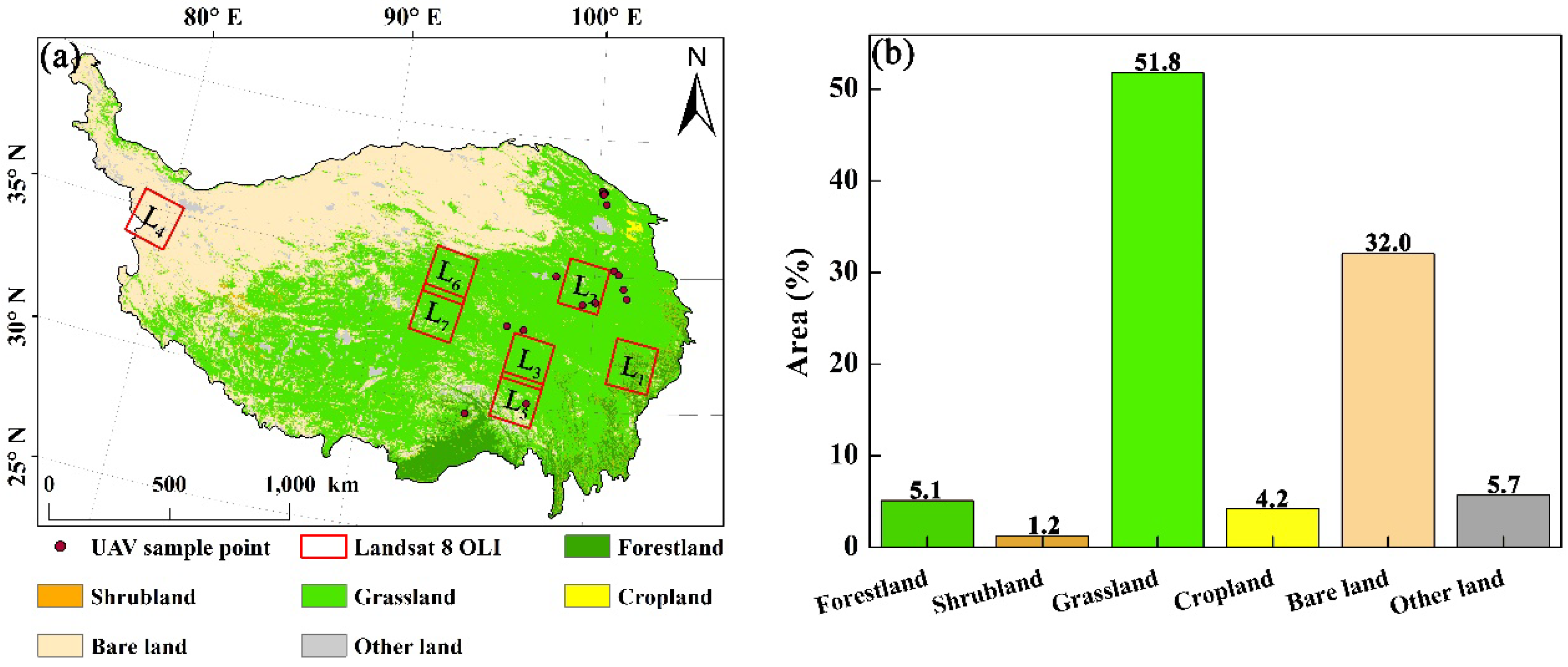
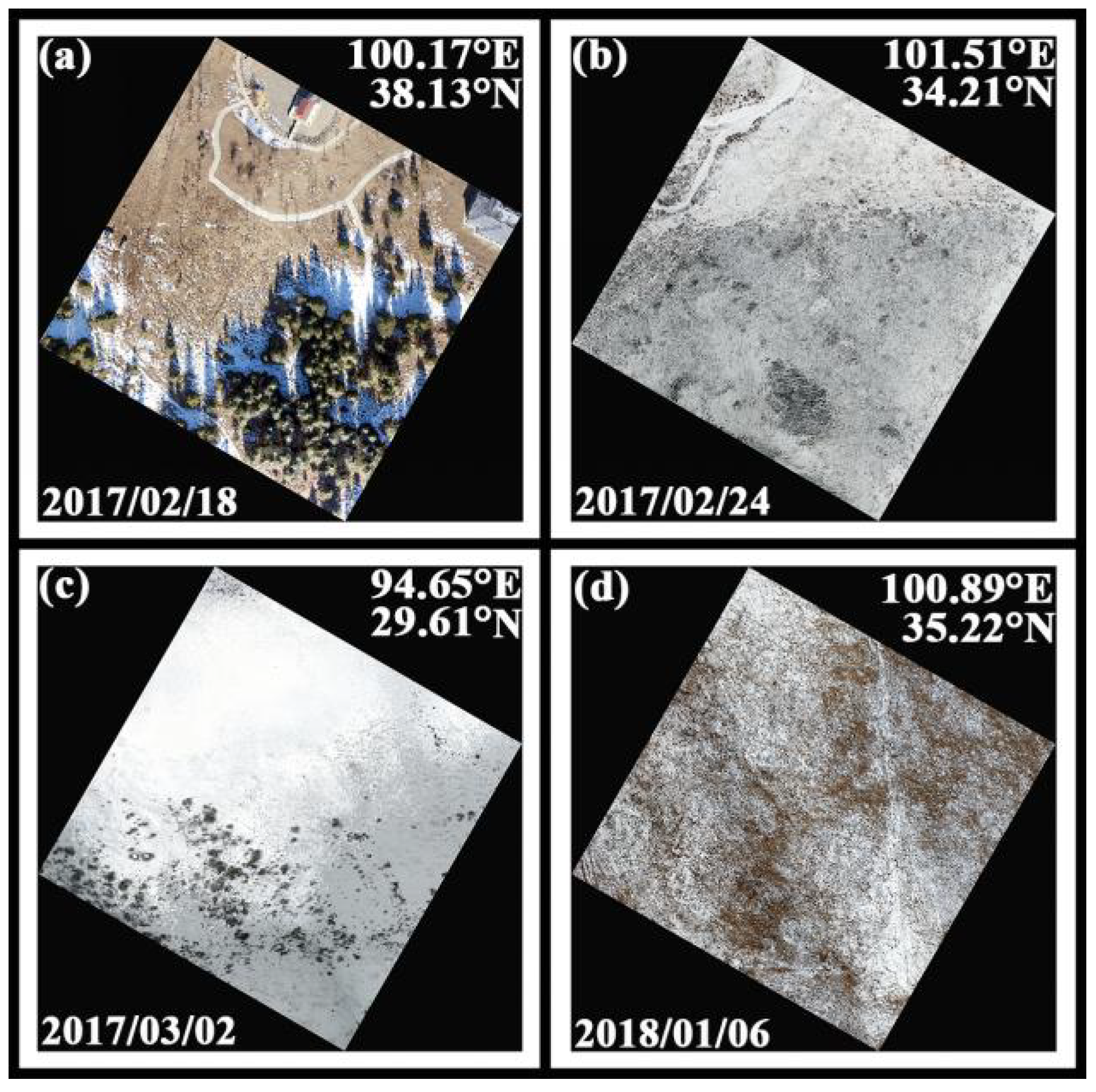
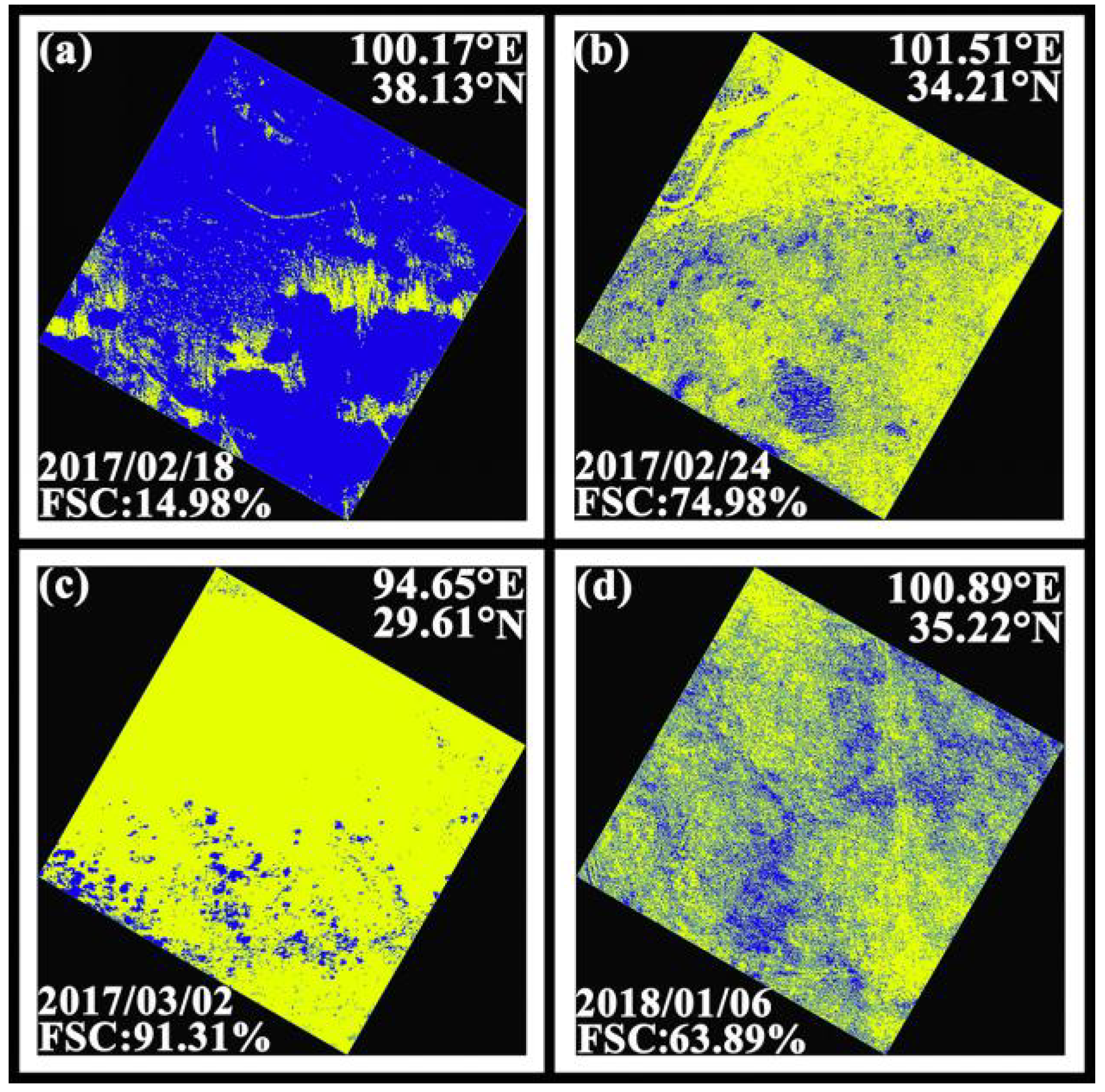
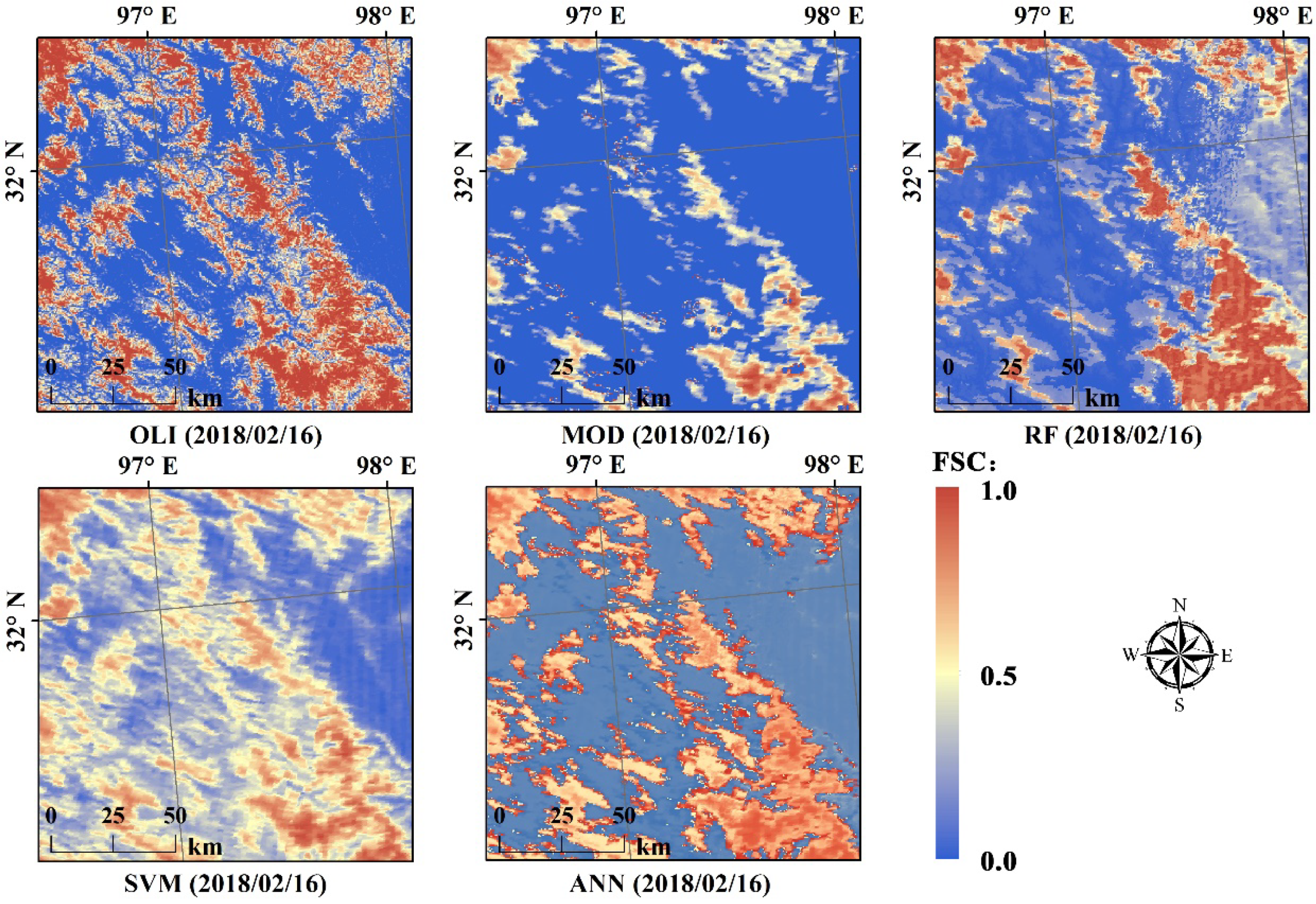
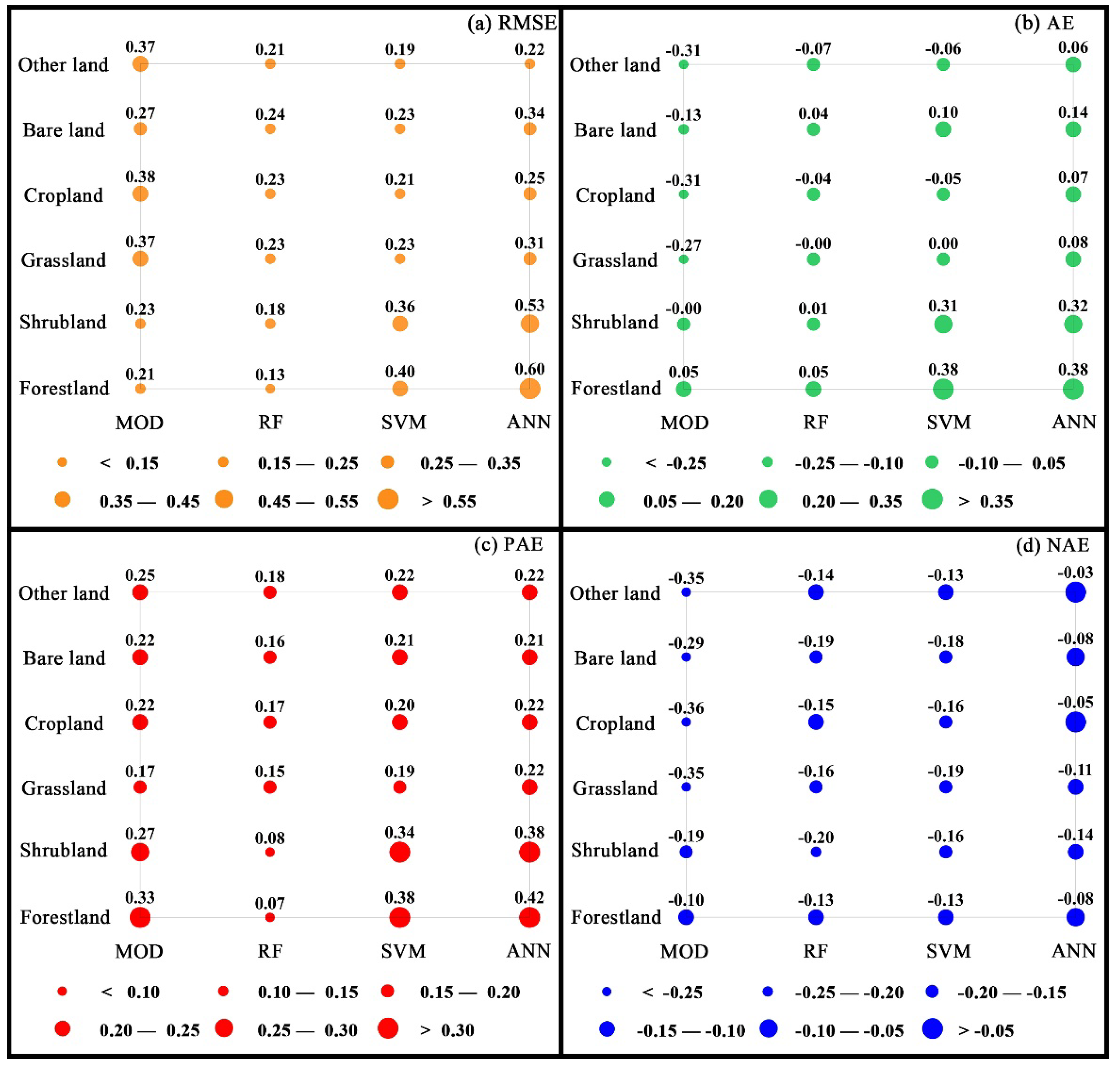
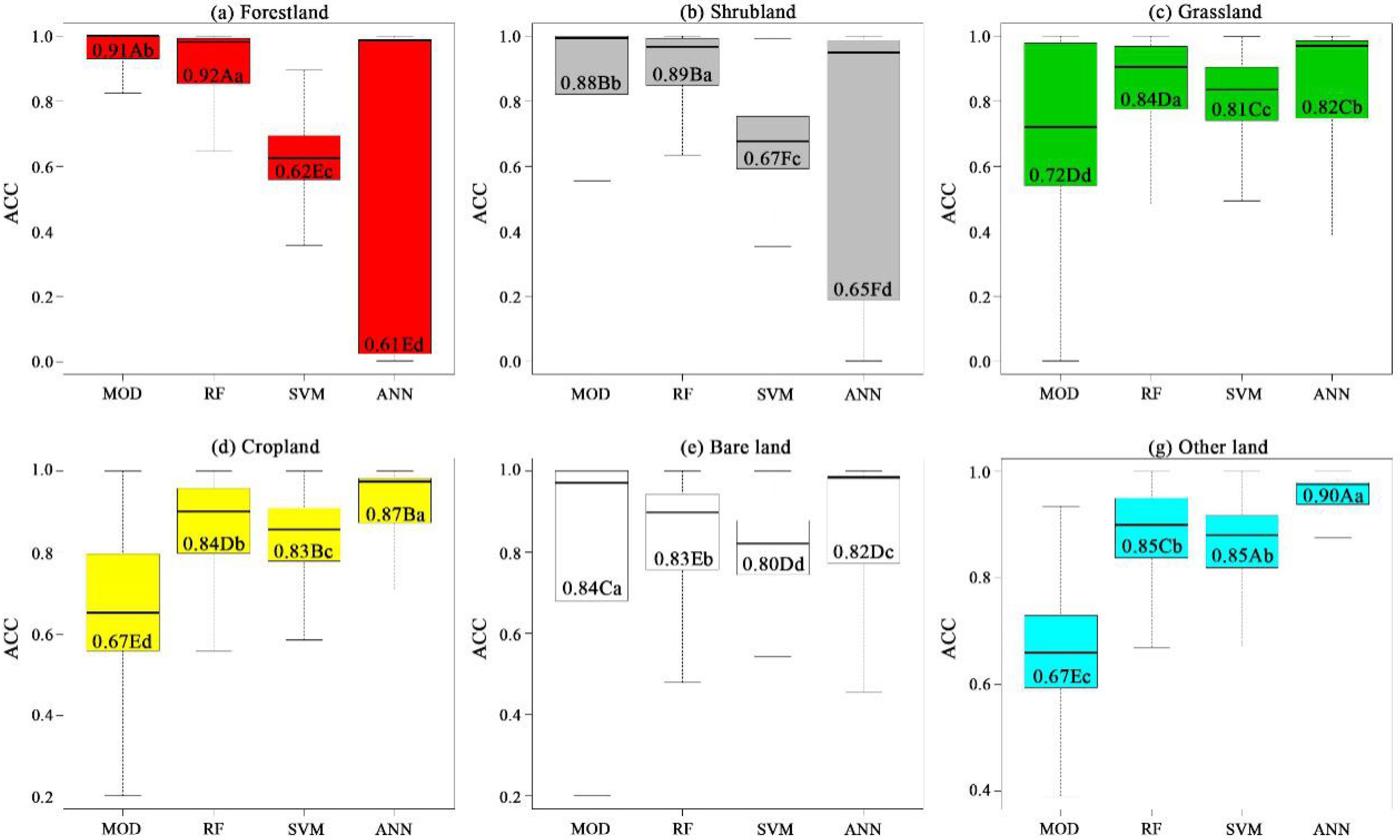


| ID | Row | Line | Time | Cloud (%) |
|---|---|---|---|---|
| L1 | 131 | 38 | 2018.03.15 | 2.04 |
| L2 | 133 | 36 | 2017.11.05 | 1.46 |
| L3 | 134 | 38 | 2018.02.16 | 3.59 |
| L4 | 146 | 36 | 2018.01.03 | 2.90 |
| L5 | 134 | 39 | 2018.02.16 | 2.54 |
| L6 | 137 | 36 | 2017.11.01 | 1.43 |
| L7 | 137 | 37 | 2017.11.01 | 4.26 |
| Factor | R2 | Pearson | ||||
|---|---|---|---|---|---|---|
| Linear | Logarithm | Power | Exponential | Correlation | Significance | |
| NDSI | 0.74 | — | — | 0.82 | 0.86 | 0.00 ** |
| NDVI | 0.01 | — | — | 0.00 | –0.10 | 0.65 |
| Altitude | 0.26 | 0.27 | 0.27 | 0.27 | 0.51 | 0.01 ** |
| Longitude | 0.00 | 0.00 | 0.00 | 0.00 | 0.02 | 0.92 |
| Latitude | 0.01 | 0.01 | 0.02 | 0.06 | –0.10 | 0.65 |
| R1 | 0.66 | 0.69 | 0.73 | 0.63 | 0.81 | 0.00 ** |
| R2 | 0.64 | 0.69 | 0.70 | 0.61 | 0.80 | 0.00 ** |
| R3 | 0.66 | 0.70 | 0.75 | 0.63 | 0.81 | 0.00 ** |
| R4 | 0.67 | 0.70 | 0.75 | 0.64 | 0.82 | 0.00 ** |
| R5 | 0.47 | 0.48 | 0.47 | 0.47 | 0.69 | 0.00 ** |
| R6 | 0.01 | — | — | 0.04 | 0.11 | 0.60 |
| R7 | 0.20 | 0.21 | 0.19 | 0.18 | –0.44 | 0.03 * |
| RMSE | AE | NAE | PAE | |
|---|---|---|---|---|
| MOD | 0.33 | −0.21 | −0.32 | 0.20 |
| RF | 0.23 | 0.01 | −0.17 | 0.15 |
| SVM | 0.23 | 0.05 | −0.18 | 0.21 |
| ANN | 0.33 | 0.12 | −0.09 | 0.23 |
| MOD | RF | SVM | ANN | |
|---|---|---|---|---|
| ACC | 0.77 | 0.84 | 0.80 | 0.81 |
© 2020 by the authors. Licensee MDPI, Basel, Switzerland. This article is an open access article distributed under the terms and conditions of the Creative Commons Attribution (CC BY) license (http://creativecommons.org/licenses/by/4.0/).
Share and Cite
Liu, C.; Huang, X.; Li, X.; Liang, T. MODIS Fractional Snow Cover Mapping Using Machine Learning Technology in a Mountainous Area. Remote Sens. 2020, 12, 962. https://doi.org/10.3390/rs12060962
Liu C, Huang X, Li X, Liang T. MODIS Fractional Snow Cover Mapping Using Machine Learning Technology in a Mountainous Area. Remote Sensing. 2020; 12(6):962. https://doi.org/10.3390/rs12060962
Chicago/Turabian StyleLiu, Changyu, Xiaodong Huang, Xubing Li, and Tiangang Liang. 2020. "MODIS Fractional Snow Cover Mapping Using Machine Learning Technology in a Mountainous Area" Remote Sensing 12, no. 6: 962. https://doi.org/10.3390/rs12060962
APA StyleLiu, C., Huang, X., Li, X., & Liang, T. (2020). MODIS Fractional Snow Cover Mapping Using Machine Learning Technology in a Mountainous Area. Remote Sensing, 12(6), 962. https://doi.org/10.3390/rs12060962






